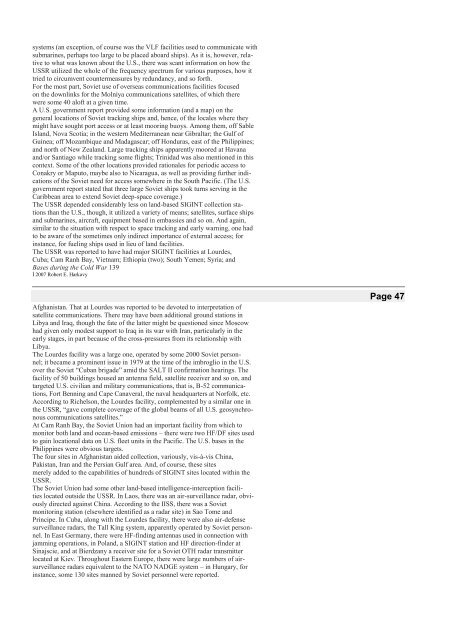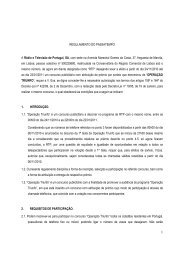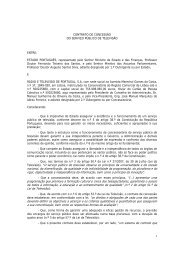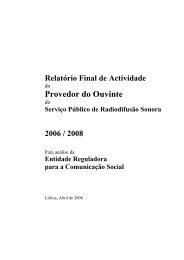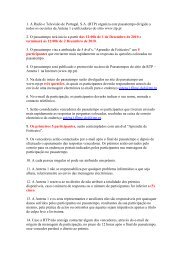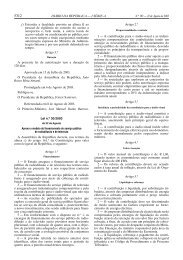<strong>the</strong> lesser number of aligned client states available to <strong>the</strong> Soviet Union in <strong>the</strong>Third World; <strong>the</strong> practice of utilizing a larger numbers of satellites with shorterlives; and <strong>the</strong> more open nature of Western societies which reduced <strong>the</strong> (relative)Soviet requirements for proliferated intelligence facilities.The USSR had nothing, for instance, comparable to <strong>the</strong> U.S. SOSUS networkfor tracking submarines, though <strong>the</strong>re was a report in 1978 of a Soviethydrophone apparatus washed ashore in Iceland. The Soviets relied more onsurface ships and perhaps also submarines and aircraft-sown sonabuoys fordetection of U.S. submarines. It maintained about 50 auxiliary intelligence shipsfor ASW work, which maintained a constant presence near important continentalU.S. bases such as Charleston, South Carolina; Kings Bay, Georgia;Norfolk, Virginia; Mayport, Florida; and Bangor, Washington; as well as atHoly Loch, Scotland.And, unlike <strong>the</strong> U.S., <strong>the</strong> USSR apparently made no use of external communicationsand/or navigation facilities in connection with submarines on patrol.Several sources reported that communications with submarines stationed at greatdistances from <strong>the</strong> USSR were handled by a network of some 26 VLF and LFtransmitters within <strong>the</strong> USSR itself, apparently sufficient to cover <strong>the</strong> patrolareas of Soviet SSBNs and SSNs; in <strong>the</strong> former case, most were kept close tohome in <strong>the</strong> “bastions,” or on stations in <strong>the</strong> Atlantic or Pacific oceans withinrange of <strong>the</strong> home communications stations. Ford referred to six long-rangeradio transmitters (at Petropavlovsk, Vladivostok, Dikson Ostrov, Kaliningrad,Matochin Shar and Arkhangelsk) that gave orders to Soviet submarines. In addition,Arkin and Fieldhouse reported a three-station network of “Omega-type”VLF transmitters at Krasnodar, Komsomolsk and Rostov. They also detailed aconsiderable number of LORAN-C type “Pulsed Phase Radio NavigationSystem” stations, organized by chains along <strong>the</strong> western and eastern littorals of<strong>the</strong> USSR, used to position submarines.Soviet submarines apparently also received communications from satellites<strong>during</strong> brief surfacing. And, one source indicated <strong>the</strong> possibility of Soviet use ofcommand and control submarines for relaying communications to o<strong>the</strong>r underseascraft within communications distance.The Soviet global ground network of space-tracking and satellite controlfacilities was, of course, far less extensive than that of <strong>the</strong> U.S. Again, this was afunction of <strong>the</strong> far more extensive use of ship-borne facilities as well as of <strong>the</strong>lesser external needs dictated by <strong>the</strong> larger land mass of <strong>the</strong> USSR, particularlyin relation to many satellite orbits which allowed direct transmission to <strong>the</strong>USSR.At <strong>the</strong> core of <strong>the</strong> Soviet space-surveillance system was a network of at least12 sites within <strong>the</strong> USSR claimed to be “equipped with receivers to measureDoppler shifts in radio signals, tracking radars, and photo <strong>the</strong>odolites and whichtransmit data to a central computation center.” Additionally, radars associatedwith anti-ballistic missiles (ABM) – Pushkino, Hen House, Try Add and DogHouse – are said to have had space-tracking capabilities, along with <strong>the</strong> controversial(in <strong>the</strong> context of ABM treaty verification) radar at Abalakova.138 <strong>Bases</strong> <strong>during</strong> <strong>the</strong> <strong>Cold</strong> <strong>War</strong>İ 2007 Robert E. HarkavyOutside <strong>the</strong> USSR, <strong>the</strong>re were a number of tracking stations in foreign countries.These were reported in Egypt (Helwan and Aswan) before <strong>the</strong> Egypto–Soviet break, Mali, Guinea, Cuba and Chad, as well as in Czechoslovakia andPoland. At Santiago de Cuba, for instance, <strong>the</strong>re was an Interkosmos laser radarand also a KIM-3 tracking camera, presumably functionally equivalent to <strong>the</strong>U.S. Baker-Nunn or GEODSS systems. Perhaps overlapping this grouping, <strong>the</strong>rewere reports of an Interkosmos laser tracking program (using a laserrangefinder) involving facilities in Egypt, Bolivia, India and Cuba. It is believedthat tracking was carried out at Khartoum in <strong>the</strong> Sudan and Afgoi in Somalia.But just because <strong>the</strong> Soviet Union was reluctant to become too dependent onforeign land-based stations, it placed considerable emphasis upon shipbornespace-tracking (and also missile-tracking) systems. This involved more than tenships – a Soviet source noted that even despite <strong>the</strong> nation’s large land mass,space vehicles were within direct visibility from Soviet territory only for aboutnine hours out of 24.In <strong>the</strong> field of communications too, <strong>the</strong> Soviet Union was far less dependent onforeign land bases than <strong>the</strong> U.S.; correspondingly, far more reliant on ship-bornePage 45Page 46
systems (an exception, of course was <strong>the</strong> VLF facilities used to communicate withsubmarines, perhaps too large to be placed aboard ships). As it is, however, relativeto what was known about <strong>the</strong> U.S., <strong>the</strong>re was scant information on how <strong>the</strong>USSR utilized <strong>the</strong> whole of <strong>the</strong> frequency spectrum for various purposes, how ittried to circumvent countermeasures by redundancy, and so forth.For <strong>the</strong> most part, Soviet use of overseas communications facilities focusedon <strong>the</strong> downlinks for <strong>the</strong> Molniya communications satellites, of which <strong>the</strong>rewere some 40 aloft at a given time.A U.S. government report provided some information (and a map) on <strong>the</strong>general locations of Soviet tracking ships and, hence, of <strong>the</strong> locales where <strong>the</strong>ymight have sought port access or at least mooring buoys. Among <strong>the</strong>m, off SableIsland, Nova Scotia; in <strong>the</strong> western Mediterranean near Gibraltar; <strong>the</strong> Gulf ofGuinea; off Mozambique and Madagascar; off Honduras, east of <strong>the</strong> Philippines;and north of New Zealand. Large tracking ships apparently moored at Havanaand/or Santiago while tracking some flights; Trinidad was also mentioned in thiscontext. Some of <strong>the</strong> o<strong>the</strong>r locations provided rationales for periodic access toConakry or Maputo, maybe also to Nicaragua, as well as providing fur<strong>the</strong>r indicationsof <strong>the</strong> Soviet need for access somewhere in <strong>the</strong> South Pacific. (The U.S.government report stated that three large Soviet ships took turns serving in <strong>the</strong>Caribbean area to extend Soviet deep-space coverage.)The USSR depended considerably less on land-based SIGINT collection stationsthan <strong>the</strong> U.S., though, it utilized a variety of means; satellites, surface shipsand submarines, aircraft, equipment based in embassies and so on. And again,similar to <strong>the</strong> situation with respect to space tracking and early warning, one hadto be aware of <strong>the</strong> sometimes only indirect importance of external access; forinstance, for fueling ships used in lieu of land facilities.The USSR was reported to have had major SIGINT facilities at Lourdes,Cuba; Cam Ranh Bay, Vietnam; Ethiopia (two); South Yemen; Syria; and<strong>Bases</strong> <strong>during</strong> <strong>the</strong> <strong>Cold</strong> <strong>War</strong> 139İ 2007 Robert E. HarkavyAfghanistan. That at Lourdes was reported to be devoted to interpretation ofsatellite communications. There may have been additional ground stations inLibya and Iraq, though <strong>the</strong> fate of <strong>the</strong> latter might be questioned since Moscowhad given only modest support to Iraq in its war with Iran, particularly in <strong>the</strong>early stages, in part because of <strong>the</strong> cross-pressures from its relationship withLibya.The Lourdes facility was a large one, operated by some 2000 Soviet personnel;it became a prominent issue in 1979 at <strong>the</strong> time of <strong>the</strong> imbroglio in <strong>the</strong> U.S.over <strong>the</strong> Soviet “Cuban brigade” amid <strong>the</strong> SALT II confirmation hearings. Thefacility of 50 buildings housed an antenna field, satellite receiver and so on, andtargeted U.S. civilian and military communications, that is, B-52 communications,Fort Benning and Cape Canaveral, <strong>the</strong> naval headquarters at Norfolk, etc.According to Richelson, <strong>the</strong> Lourdes facility, complemented by a similar one in<strong>the</strong> USSR, “gave complete coverage of <strong>the</strong> global beams of all U.S. geosynchronouscommunications satellites.”At Cam Ranh Bay, <strong>the</strong> Soviet Union had an important facility from which tomonitor both land and ocean-based emissions – <strong>the</strong>re were two HF/DF sites usedto gain locational data on U.S. fleet units in <strong>the</strong> Pacific. The U.S. bases in <strong>the</strong>Philippines were obvious targets.The four sites in Afghanistan aided collection, variously, vis-à-vis China,Pakistan, Iran and <strong>the</strong> Persian Gulf area. And, of course, <strong>the</strong>se sitesmerely added to <strong>the</strong> capabilities of hundreds of SIGINT sites located within <strong>the</strong>USSR.The Soviet Union had some o<strong>the</strong>r land-based intelligence-interception facilitieslocated outside <strong>the</strong> USSR. In Laos, <strong>the</strong>re was an air-surveillance radar, obviouslydirected against China. According to <strong>the</strong> IISS, <strong>the</strong>re was a Sovietmonitoring station (elsewhere identified as a radar site) in Sao Tome andPrincipe. In Cuba, along with <strong>the</strong> Lourdes facility, <strong>the</strong>re were also air-defensesurveillance radars, <strong>the</strong> Tall King system, apparently operated by Soviet personnel.In East Germany, <strong>the</strong>re were HF-finding antennas used in connection withjamming operations, in Poland, a SIGINT station and HF direction-finder atSinajscie, and at Bierdzany a receiver site for a Soviet OTH radar transmitterlocated at Kiev. Throughout Eastern Europe, <strong>the</strong>re were large numbers of airsurveillanceradars equivalent to <strong>the</strong> NATO NADGE system – in Hungary, forinstance, some 130 sites manned by Soviet personnel were reported.Page 47
- Page 2 and 3: This provided the U.S. access to a
- Page 4 and 5: ecame a hot issue within Japan, and
- Page 6 and 7: SpainRotaMajor naval base; also air
- Page 8 and 9: eturn to the link here with aircraf
- Page 10 and 11: which were in Fairbanks (Alaska), T
- Page 13: Molesworth), Belgium (Florennes), t
- Page 17 and 18: III,” 14 stations giving flexible
- Page 19 and 20: wire retaliation strike plan. The n
- Page 21 and 22: Ocean surface surveillance47The U.S
- Page 23 and 24: each site, providing variable cover
- Page 25 and 26: Pinetree LineCanadaBroughton Island
- Page 27 and 28: that is, the Limited Test Ban Treat
- Page 29 and 30: Missile Crisis.68At another level,
- Page 31 and 32: Access for Soviet surface ships.Per
- Page 33: nel in Libya, whose air force compr
- Page 37 and 38: Madagascar). There was also a signi
- Page 39 and 40: Aden, Bahrain, Malta, Mauritius, Si


